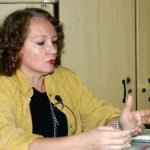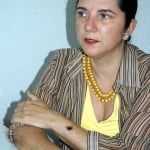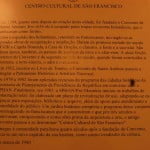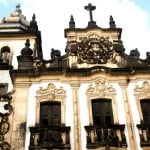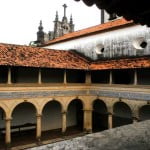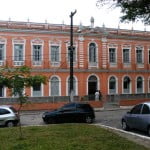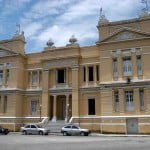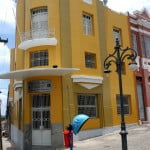Thursday – 13 – 10 – 2005.
We are about to start our trip along the coast of the seventh coastal state that the Endless Sea visits. And please prepare yourselves: Paraiba has many good examples to give to the rest of the country. We will talk to some experts from the academic community, NGOs, the Government, and from Society, in order to have more data based on researches, statistics, technical information as well as from backstage. We had a good start.
Today, early in the morning, our efficient reporter and producer, Paulina Chamorro, made an appointment with Maria Bethania Matos de Carvalho from SUDEMA – (the Environment Administration Agency) who coordinates Paraiba’s Coastal Management. She is unique.
She is a dynamic person and has Paraiba’s typical accent. Maria Bethanea talks easily and enthusiastically about the measures taken in that area. In 1970, João Pessoa’s House of Representatives passed a law which didn’t allow buildings higher than three floors within an area 500 meters from the beach. Later, when Paraibanos were writing their state constitution, in 1989, this measure was extended to the whole coastal zone of the state (see the text of the Constitution at the end of the diary). Since the height was not specified in the text, only “three floors”, one paragraph was added in which the maximum height allowed is 12 meters and 90 cm.
In fact, the coast between João Pessoa and Cabedelo which we were able to see from the sea and the area itself is occupied in a fairly less destructive and predatory way compared with the other states we visited. It was a surprise to me because I imagined something else. I didn’t know João Pessoa had plenty of trees and a beautiful historical patrimony. I didn’t know either that people here used to march to put pressure on politicians asking to banish high buildings from the beaches. And they succeeded! It is amazing to know that at least they acted in a “progressive” way, correctly, protecting the majority, the sustainability, the public patrimony and at the same time this area was not led to stagnation. They simply try a sustainable occupation. I won the day and learned more about Paraiba. In the evening, I was already a big fan of Paraiba and its inhabitants. We have here a good example. Additionally, the city is surrounded by the Atlantic Forest which can be seen because of the short buildings. If people from Paraiba were able to refrain sky scrapers from being built, it is because of the “public opinion pressure” factor. It is hard and time consuming, it requires mobilization, but putting citizenship into practice works many times. In Brazil, there are already many successful examples, and this seems to be another one. But this time it is even more significant because it means the successful action of the whole state.
Maria Bethania talked freely to us and didn’t hesitate in condemning either the crustacean culture as it occurs in Ceara and Rio Grande do Norte, or the big resorts with their mortal capacity of destroying any landscape. She told us that, “when they saw the serious situation of Rio Grande do Norte’s crustacean culture” they decided to do something in advance, “in order to know how to manage this and other issues on Paraiba’s coast”, that’s why Paraiba’s Management Coastal Program was created soon, in 1987, together with the federal government.
A bit faithless, I ask: are laws obeyed here? And I got this pearl as an answer: “Look, Paraibanos’ ability to organize and protest dates from a distant past”. Congratulations Maria Bethanea and Paraibanos in general. I will spread this example especially because this is one of the Endless Sea’s greatest goals: to show the occupation as it is; to show the dangers, questionable or bad examples, and likewise, but more emphatically, to spread, to talk about and project good examples. This is how we can show more effectively to everybody that it is possible, with political will and mobilization, it is very often possible.
But Paraiba is not all roses. On João Pessoa and Cabedelo’s shore we may see a higher building here and there, but just a few and they were built in the 70’s. Two others that had not obeyed the law and broke the building standards were demolished. Unfortunately, as far as sanitation is concerned, the rates of both cities cannot be used as examples, although they are better than the average coastal capitals and big cities. Cabedelo with 43 thousand inhabitants, 92% of their homes have garbage collection and 0,009% have waste treatment. João Pessoa with 597.934 thousand inhabitants (2000 IBGE’s data) 95% of their homes have garbage collection and 43% have waste treatment.
Real estate speculation, which is so present in the northeast of Brazil, can be also seen especially on the southern coast where some resorts have already been built, but a little bit far from the coast. Nevertheless, speculation here is not as devastating as it is in Ceara and Rio Grande do Norte. According to Maria Bethanea, the biggest threats to the coastal zone are: urban development (progress…), port activities, crustacean culture, and predatory tourism, almost the same we have already pointed out.
They are aware of the crustacean culture. She says that here “this is not an alarming issue” and also that the biggest farm was created when the permit was unnecessary (today it is compulsory and it is given by the agency she is in charge of, SUDEMA) and it is in an area where there was a salt industry before, consequently, it had already been devastated. In spite of that, the farm is supposed to “adapt itself to the new standards” progressively.
We made another appointment with her and after lunch we had an interview with Ierecê Lucena Rosa, NUPREMAR’s coordinator – The Research and Sea Studies Center from Paraiba’s Federal University. Again, we met a dynamic and enthusiastic woman, fond of her studies and optimistic, despite everything.
Ierecê is particularly involved in the study of sea horses, this exotic type of fish whose reproduction is unique in its gender and this simple fact justifies that experts study them. She told us that all types of sea horses are on the lists of living beings threatened with extinction. Man is obviously the biggest predator. Unfortunately, this nice little animal is sought by people as a talisman, an icon of popular beliefs. In Belém, at Ver o peso market we saw that it is sold dry in big amounts hanging in the free market stands. This little animal is used in aquariums, it is often appreciated in the smuggling of wild species and to make things worse, its habitat are mangrove areas that have been destroyed and polluted. The result couldn’t be different: it is threatened with extinction. At this point, fortunately, there are people like Ierecê.
She is also against the project of shrimp breeding farms in the Northeast. I asked her to point out some of the reasons that explain the spree of the shrimp breeding and she agrees to tell us something about: the lack of basic research ends by opening the door for “closed packages” from abroad, like this one “imported” from Asia and Central America, and warns about the fact that “the introduction of organisms is part of the Special Fishing Department’s policy, directly connected with the Presidency”. And she also calls our attention to the difficulty in dealing with two important factors in the crustacean culture: “ICMS (Goods and Service Tax) and job creation”.
Afterwards, she talked about the need of research and studies not very often carried out in this country. There isn’t, for example, any reference study on the concrete reefs issue. “SEAP decided that some Brazilian coastal states should receive these reefs, but there are no base data”. They might even bring some practical result, like in certain areas in the Southeast, where they are an obstacle to trawl-net fishing. But they may also bring problems since previous studies were not carried out. In some coastal areas, tires have been used as artificial reefs without any scientific evidence. “What can result from that?” she asks.
Ierecê is very sarcastic and has a good sense of humor. When I talked about lack of inspection, she immediately said that “in the 16th century, French had already shown that it was difficult to inspect 8 thousand kilometers of coast when they were here looking for Pau Brasil”.
Despite all the problems, she is not discouraged, and says that “the species’ decreasing number makes us find new alternatives” and there are not only bad examples, there are good ones too such as the Tamar Project, the Rotator Dolphin, the Jubarte Whale, algae breeding in Acau, on the south coast of Paraiba, which we will be visiting soon, or Macau’s inhabitants reaction, on the north coast of Rio Grande do Norte, who rebelled against the establishment of a huge tourism project, something that devastates the local environment, and because of this hard reaction of the community, the project was aborted.
It was a nice talk. I was encouraged by the way this state was dealing with the issues involving the maritime space. Frankly, I thought that I would finish the trip without seeing any good example on coastal areas. I knew there were a few successful experiences in some specific areas and I expected with the trip to have more information in order to spread it and contribute by multiplying it. But the way the public issue as a whole was conducted here, with policies that many times anticipate facts, as it was the case here, at least as far as building skyscrapers are concerned, it was a surprise to me. It was a nice and pleasant surprise.
Friday, 14 – 10 – 2005.
We shot João Pessoa’s historical center today, a city founded in the 16th century. It still has a significant amount of well preserved buildings, some of great beauty and architectonic value, such as São Francisco’s church, founded in 1589, four years after the city foundation (see pictures). I liked João Pessoa as a whole; the city is clean and well treated. It is well signaled, it is easy to go by car from Cabedelo’s port to João Pessoa. One city is really next to the other. It was not clear to me where one ended and the other started. Cabedelo, where the port is, has about 43 thousand kilometers, and João Pessoa is the capital of the state of Paraiba. Both were first occupied on Sanhau river’s banks, Paraiba do Norte’s arm. This is how the Portuguese used to settle.
Paraiba do Norte was chosen as a priority area for the government’s coastal zoning, consequently for the management plan. The diagnosis is emblematic of our times. The problems pointed out by the plan are: conurbation (there are five districts in the estuary of the river summing up a total of approximately 900 thousand people), the growing aquiculture activity (a small part of the mangroves is devoted to the shrimp breeding), the port activity and a fishing terminal without the environmental permit control. It is important to stress that these districts also lack of waste treatment system. In one of them, Lucena, 70% of the houses use septic caves as final destination of their waste, nevertheless in some areas downtown there are open air drains. The other problem that devastates Paraiba’s coastal zone is the use of herbicides in sugar cane plantations alongside mangroves. This is decimating the uça crab production, causing serious problems to inhabitants who make their living from extraction. Paraiba is not all roses…
Well, today we have spoken to Carla Marcon, from São Paulo, who has been living here for a long time and works for Ibama. Carla is the head of Barra de Mamanguape’s APA with 14.640 hectares, one of the most beautiful and richest areas in biodiversity, in the north of João Pessoa. The first Peixe-boi project base inaugurated in 1993 was there. She spoke enthusiastically about her work as well as about APA, which we will be visiting soon. Additionally, she mentioned aspects that threaten that area which is surrounded by sugar cane plantations – effluent producers – as well as the existence of 200 shrimp tanks. In spite of everything, it is a very rich area as far as biodiversity is concerned. It is surrounded by mangroves, where peixe-boi and other mammals live, and a sanctuary of sea horses. According to Carla, the crustacean culture has not yet caused too much damage because it is just the beginning of the activity, fishes haven’t been caught yet, and it is during this phase that waters are polluted. This stage of the shrimp breeding has not yet occurred because Ibama was seizing some farms and at last one of them was able to get a preliminary order that allowed them to continue the activity. Carla said that most of them were established with no EIA-Rima, when the study was compulsory, disobeying the law or being helped by Ibama’s omission. For one reason or another, they have been carrying out their activity although it is an APA. The results are not yet visible, but they will be soon. We have already seen that in Ceara and Rio Grande do Norte… Carla mentioned an additional threat: tourism. Many European groups spoke to her about their interest in buying land and building. Fortunately, there are some legal restrictions since it is an APA. Anyway, it is important that Paraibanos are aware of the situation and react by resisting. Otherwise, foreigners will buy everything soon and turn an APA into a theme park without any interest, or something of the sort.
We will be visiting Mamanguape soon, we will then see to what extent sugar cane, real estate speculation and crustacean culture have changed the area.
Tomorrow, we will start our trips by car along the coast. Paraiba’s coast, like other parts of the coast in the Northeast, is full of reefs with obstructed narrows, through which boats like the Endless Sea cannot sail. It will rest here. After all it’s been away for over a year.
Saturday, 15 – 10 – 2005.
We started our trip southwards early in the morning, going down to the coast from João Pessoa.
Our first stop was Intermares beach on Cabedelo’s shore. The next one was Tambau, in João Pessoa. In spite of being both urban, there aren’t many buildings, commonly seen in the two states we visited previously. The view is wider because the buildings are not high, allowing the wind to blow in the city and to attenuate the heat.
We drove along the avenue that leads to the beach until Cabo Branco (White Cape), a sort of promontory where Cabo Branco’s lighthouse is. It used to be Brazil’s most eastern point, therefore, the closest to Africa. However, erosion devastated part of the land and the sediments are at Seixa’s end which is 200 meters to the south, so today this point is Brazil’s eastern end. The beach is narrow and full of coconut palms, and again, no cement is seen. There are only wood stands with straw roofs where bars and restaurants serve customers.
On our way, on the right side where the continent is, the Atlantic forest remainders follow us. It is a beautiful contrast: on the left, we have the view of the sea in blue and turquoise shades, on the right, the dark green of the crown of the trees.
A few kilometers further, we arrived at Praia do Sol (Sun Beach), with huge cliffs and a certain amount of houses that belong to summer visitors, but rather inwards. Fortunately, this is very frequently the rule in Paraiba. At the densest beaches, houses are built inwards; they are rarely built on the sand. This is another example of Paraibanos’ discernment. I’ve repeated many times that no one has the right to damage public areas, generally very beautiful, and frequently very fragile, like beaches, for example. We have visited seven states so far, and Paraiba is the only state that conducted occupation carefully.
We continued our way southwards and arrived at the estuary of Gramame’s river. This is another place on Paraiba’s coast that is like paradise. A beautiful beach, cut in the middle by the estuary of the river. Here, tourists may sit in the shade of stands made of straw and coconut palm trunks, have something to drink or have lunch. Again, concrete was banished on the shore, fortunately. We talked to the owner of a bar who told us that every time the mayor suggests the idea of “urbanizing” the beach, local inhabitants react. These humble people react immediately and don’t allow these “improvements”.
Then we went to Jacumã and Carapebus, two other dense beaches on the south coast. Actually, there are many houses built on the edge of the beach.
Going down a little bit further, we passed by Tabatinga, a small creek surrounded by cliffs. Then we arrived at Coqueirinho beach, probably the most beautiful beach in this area of Paraiba’s coast. In Coqueirinho, there are a few mansions, summer visitors’ houses, whose owners live in João Pessoa and Recife, since it is near Pernambuco’s border. Conama’s resolution – allowing houses to be built 300 meters away from the high tide area – is not obeyed. Anyway, they are always built behind the first row of trees and coconut palms and they are never higher than the crowns, therefore, when you see it from the sea, the landscape is almost unchanged.
Finally, our last stop was Tambaba, formed by two creeks, with strong waves and not dense. Tambaba is famous for being Brazil’s first naturist beach. You have to walk along a small sand strip, a sort of preparatory antechamber, for those who want to feel completely at ease and have a good time naked. We interviewed Sonata’s directors (Tambaba’s Naturist Society), who were completely naked, and explained how this society works protecting their interests.
We were near Pernambuco’s border so we decided to return from there. We kept in our minds an excellent impression, after all, the south is Paraiba’s most occupied coast, but there are neither aberrant buildings nor resorts devastating the landscape. Only a series of beaches, generally with narrow sand strips and not as long as Ceara and Rio Grande do Norte’s beaches. It is also true that real estate speculation has not yet reached the same level of that in those two other states and tourism investors haven’t been very aggressive. Consequently, this issue is not definite. Anyway, it is encouraging to see an occupation like this in the north-east which has been devastated by mass tourism so predatory for the coastal area.
Sunday, 16 – 10 – 2005.
We have explored the neighborhood today. We have been to Areia Vermelha (Red Sand), a sand island, in front of Cabedelo, which can be seen only at low tide. It is surrounded by reefs where small lagoons are formed with crystalline water. Tourists love it. This place is really wonderful, but too many people come here because it is next to the coast. Approximately 100 meters separate the island from the continent. It is an APA area, but no one here gives information or controls tourists. This is why we saw some people diving with harpoons, others stepping on fragile reefs, they cannot realize all the damage caused.
Then we went to Santa Catarina’s fortress, built in the 16th century on Paraiba do Norte’s banks, it is near the small cape’s end. The city of Cabedelo was named after it. It is like a polygon, like the Magi’s fort (at Christmas) and the walls are in good shape taking into account it dates from the 16th.
After that we shot a few old buildings in João Pessoa’s city center as well as the main square with a lagoon in the middle and gardens around, also designed by Burle Marx. I like João Pessoa a lot. It is a beautiful city surrounded by nature. There are huge trees in the streets, palm trees, mango trees and many other sorts from the Atlantic Forest. Like all the old cities built by Portuguese people, the old center was built at the top of a hill from which the arms of Paraiba river could be seen with mangroves all around. Wherever you look at, there is a green belt that goes as far as your eyes can see, that’s the impression you have.
Tomorrow we will go to the north coast and enter an area planted with sugar cane until the Mamanguape River’s bar, an APA where there are not only Potiguar’s settlements but also the first Peixe-boi Project’s base.
Monday, 17 – 10 – 2005.
Day dawned. We had breakfast and drove to Mamanguape, in Rio Tinto District; it is about 60 kilometers towards the north of João Pessoa. As we were leaving Cabedelo, we crossed Paraiba do Norte by ferryboat, where the Endless Sea is anchored, we landed at Costinha beach, Lucena district, on the other side of the river. Then we started our journey to Tinto River.
A few minutes after having left the urban perimeter, we saw mostly huge sugar cane plantations, on both sides of the road. And that’s what we saw all the way long.
Sugar cane has greatly destroyed the Atlantic Forest in the Northeast since the 17th century. This type of plantation covered almost the whole area where before there was a forest with the richest biodiversity. Thus started the second economic cycle of our history. The first, as everyone knows, was Brazil’s wood extraction. Then, Portugal chose us to be the great sugar supplier, and the Northeast offered the best results, additionally it was nearer Europe and trade winds blew on the coast, the propeller force of old times’ vessels.
After driving for about 60 kilometers northwards, we arrived at Tinto River where Mayor Magna Gerbasi welcomed us. We had an emblematic talk during which she complained about difficulties in administrating a district with 23 thousand inhabitants and an incipient economy, therefore, with unemployment. She said that since the Lundgreen’s textile factory closed down in the 90’s (Pernambucanas), local inhabitants have been unable to find jobs. She feels tied up: one part of the district is Mamanguape’s APA where very little can be done, due to Ibama’s control; the other part is Potiguars’ reserve controlled by Funai, where again nothing can be done. And she asks, “What shall we do?” She complained a lot, saying that “we know there are investments coming to Pipa or Buzios (beaches on Rio Grande do Norte’s coast, near Paraiba’s border) but here at Tinto River, resorts are not allowed by Ibama”… I tried to explain to her that maybe that would not solve the problem; Pipa is like an area of slum houses where unplanned tourism brought problems such as drug dealers, violence and a change in the area. I suggested her and the other mayors of Paraiba’s coastal districts to make an effort to boost lower environmental impact tourism with pousadas that don’t change the landscape. I reminded her that in 2005 ecological tourism made 260 billion dollars! Frankly, I don’t think I could change her mind.
From the City Hall, we went by car to the APA’s interior and Carla Marcon, the person in charge of this area, was with us. On our way we talked about inevitable conflicts, like the one we had just heard of: the mayor’s immediate interests and the environment protection. Actually, it is not easy to conciliate progress, infrastructure investments, hotels with environment protection, especially in a country with a cruel income distribution, no planning, with strong basic needs and a tangle of laws often superposing consequently nobody knows to which judicial competence they belong. And it is because of these factors among others that many times mayors from the Northeast anticipate and approve projects that in fact should be under the federal authority. During our trip in Ceara and Rio Grande do Norte, I heard people justifying the chaotic occupation of a few dense districts with the desperate search of any kind of investment for the region and many times projects are accepted. But in the long, mid and short term they may be killing the goose that lays the golden eggs, because they are not self-sustainable: they pollute, an exceeding number of tourists for their infrastructure capacity, the landscape is definitely changed and for worse, etc.
Carla told us about two Belgian brothers who bought a big area on Miriri’s river banks in the APA and wanted to build there resorts which were obviously not approved.
She also told us that the administration rules will be ready soon and it will determine how and where building is possible. She explained to us the current threats such as five sugar mills established in the area, the pressures resulting from dealing with the sugar mill owners, the 200 tanks of crustacean culture in the APA because of the omission of the former Ibama’s head who has been sued for connivance…
Afterwards we visited the area where Peixe Boi Project’s headquarters are and it is unique with mammals which live in captivity before they are reintegrated in nature. Roberto Barbosa who is in charge of the base showed us everything in details. When we asked about the amount of animals recorded, the answer was not encouraging: from 300 to 500 individuals at most, spread on the coast from Alagoas to Maranhão. And which is the greatest threat for their survival? “If hunting was still the greatest threat in the 80’s, today it is the devastation of their natural habitat, the estuaries of quite waters with mangroves around”. Roberto mentioned the four thousand tourists who come here every year just to see the peixe boi in captivity. I remembered immediately the mayor complaining since “additionally, Ibama wants to release the peixes boi which have attracted the only tourists we have…”Roberto told us that the two animals won’t be released soon. When this occurs, others will come from Itamaracá, where there is another base of the project.
On our way back to João Pessoa with Carla Marcon serving as our guide, we stopped at Campina beach, wonderful, with dunes and coconut trees and it is already being occupied with summer houses and the tourism industry has already tried to build resorts. We have also been to Miriri’s river mouth, one of the most beautiful areas on Paraiba’s coast, with very high cliffs and a vigorous reef, full of life and completely covered with green.
Tuesday – 18- 10 – 2005.
Today we will finish recording material on João Pessoa. We started by visiting Cabedelo’s reef reserve, a beautiful reef forest preserved in the city which allows João Pessoa and Cabedelo to be surrounded by green.
Then we had a meeting in another protected area, João Pessoa’s Botanical Garden, with about 500 hectares from where comes 30% of the water of the capital. A charming person was expecting us, lawyer and biologist, regional coordinator of the Atlantic Forest’s Biosphere Reserve, Boisbaudran Imperiano. Usually, Botanical Gardens have plants from all over the world, but João Pessoa’s doesn’t. Here you only find species from the Atlantic Forest. Actually, the reserve is what was left from this biome of Paraiba’s capital. It is magnificent, especially because it is right in the middle of the city, contributing to refresh the atmosphere and bringing part of the water that is consumed. Additionally, it is a study and visiting place. Boisbaudran is quite dynamic and told us how the state was able to pass a law that prohibits sky scrapers from being built on the coast. It was like this: when Paraiba was writing its state Constitution, in 1989, right after the 1988 Federal Constitution’s promulgation, a group of institutions, NGOs, teachers and environmentalists met to offer to the state legislature the chapter on the environment. At that time, one of the most debated issues by the media was Eco 92 that took place in Rio de Janeiro and the environment protection was a predominant issue. Consequently, it was not difficult to gather an eclectic group in Paraiba among which were the Federal University, the Brazilian Bar Association, CREIA and SUDEMA, a few class associations as well as NGOs such as APAN (Paraiba’s Association of Nature’s Friends) and ABES – Brazilian Engineering Association and others.
One of the participants, architect and plastic artist Hermano José, introduced in the debate the concept of a renowned architect Le Corbusier, who suggested that the buildings nearer the coast might have a limited height. Thus, on the first street, the limit was strict, at most three floors. On the second they could be a little bit higher, thus successively, so that the highest buildings are built only from the fourth or fifth street on. Among many other suggestions, this one, which is unique in Brazil, was eventually accepted by the representatives due to the important issues discussed before Eco 92. With this promulgation, Paraiba’s constitution prohibited sky scrapers from being built on the coastal zone, turning this state into an example for the whole country.
I saw the difference and I can assure you that it is fantastic. The view from the city or the sea is infinitely bigger. You can see significant distances and see what buildings normally hide. The city seems bigger, besides, the breeze that comes from the sea goes to the interior, refreshing everything around. Beaches are less dense, the landscape is less devastated, and everybody benefits from that. The exception is the real estate speculators and the civil engineering. But they don’t give up. According to Boisbaudran, and all the others we have spoken to, every time there is a new legislation, a new government, pressures are renewed in order to change the law. Then the society reacts, putting their citizenship into practice, putting pressure, demanding and making sure that the legislation is not changed. It’s been like this since the promulgation. And this conquest has been kept so far. I hope this permanent alertness from Paraibanos remains so that at least one of the seventeen coastal states follow this example and show to the Brazilians that at least in this case, the society was heard and won; something that rarely occurs in this country.
Wednesday, 19 – 10 – 2005.
Today we haven’t a lot of things to do. We are about to finish our visit in this special state, beautiful, organized, with a unique and interesting legislation. We are going to visit Costinha again, on the other side of Paraiba do Norte River. The base of the whale fishing ships and the place where the meat of this mammal was processed was here until it was prohibited by Sarney administration in 1985. It didn’t take us long to find a fisherman unemployed today who at that time was part of the crew of one of those ships. José dos Santos explained to us how the fishing routine was. According to him, the ship whose owner was Japanese, used to put out to sea in the early morning and sailed 40 or 50 miles to find the first animals, usually Mink whales. He had to be at the top of the mast, look around and see the sprinkling water expelled upwards every time the whale breathes. After they were seen, the ships would go to that direction and sail in circles until the whale came to the surface. Then the trigger of the harpoon cannon was pulled and another enormous cetacean was captured. From 1904 to 1985, the Japanese freezer plant processed 19.800 whales, especially of the Mink and Sei kind. Today, except just a few countries, among which Japan and Iceland, whales are not killed any more. And Brazil at UN supports the whale’s sanctuary in South Atlantic. We’ve made some progress.
Thursday, 20 – 10 – 2005.
Paulina left for São Paulo yesterday to start the program editing marathon. We left towards Recife in the early morning. We sailed for 70 miles in heavy sea with winds from the south quadrant, normally SSE, south-southeast – at 24, 25 knots. Unfortunately, the wind had not yet turned towards north-east, as it is the case in summer, to make our sailing easier. Again we sailed against the wind, which requires a lot from the Endless Sea. Nothing very special during the trip, except the sailboat tossing (longitudinal swinging resulting from the prow waves we faced) and many lobster fishing ships we passed by which were fishing with compressor.
As I said, it is not all roses in Paraiba…
Around midnight we dropped anchor at Cabanga Yacht Club, in Recife. The Endless Sea will remain here until our next stage: the coast of Pernambuco. Be our guest for our next episode.
Here follows the text of Paraiba’s Constitution that sets rules on the occupation of the coast of the state.
Art. 229. The coastal zone, in the territory of the State of Paraiba, is an environmental, cultural, scenic, historical and ecological patrimony within a strip of land that is 500 meters wide from the high tide area to the interior of the continent, and it is up to the state environment protection agency to protect and preserve it in accordance with the law.
§ 1st The directing plan of the Districts on the coastal strip will regulate the buildings, obeying among other things the following requirements:
a) the areas urbanized and divided into lots will obey the staggering of the height of the buildings from 12 meters and ninety centimeters, including stilts and three floors, reaching a height of thirty-five meters, the range limit mentioned in this article;
b) in the areas that shall be urbanized, the first block must be a hundred and fifty meters away from the syzygy tide, according to what is determined in this article;
c) granting a permit to build or renovate buildings on the coast is a liability crime discordant with what is determined in this article.
§ 2nd The buildings mentioned in the previous paragraph shall obey the criteria that meet the ventilation, illumination and urban infrastructure requirements, in accordance with the demographic concentration, occupation rate and the improvement rate references.



